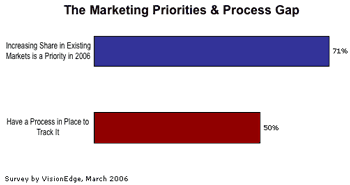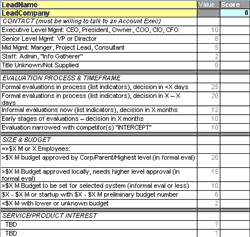Tuesday, June 27, 2006
Don’t Put the Metrics Cart Before the Strategy Horse
In a recent post I pontificated on the importance of having a systematic approach to lead generation by employing a formal lead scorecard to qualify leads prior to sending them on to the sales team. With only 50% of respondents in a survey this year by VisionEdge saying they have a process in place to track the market share growth they are trying to attain, I realized that starting with the lead scorecard was like putting the metrics cart before the strategy horse: we should first have a good picture of what demand we want to create before we try to score it. After all, whether you have a tracking process or not, how can you determine if your demand creation initiatives have been successful without some tangible pre-determined target to hit?
I thought about devising my own tool to assist in this, but then remembered a widget I came across during MarketingSherpa’s BtoB Lead Generation Summit a few years back — a simple marketing lead calculator created by one of the Summit’s well-known speakers, Mac McIntosh. While its parameters may not exactly fit every business, the fact that its stupid simple and free — two of my favorite points in any tool — make Mac’s calculator a must-have in my planning arsenal.
The third piece of a systematic, closed-loop approach to lead generation is a lead nurturing process — but that’s a topic for another post…
Thursday, June 15, 2006
Taken your Metrics Multivitamin Today?
Can it be that 72.4% of direct marketers have no marketing dashboard or performance measurement system? So says a new survey by the CMO Council. While general purpose marketers (those with broad responsibility, not just direct marketing) at big companies probably have and can afford these systems, I would guess that the vast majority of small-to-medium sized businesses share the plight of the direct marketers in the survey. Scarier still, 36.1% have no formal system for evaluating and scoring leads — a recipe for marketing malnutrition that ultimately leads to an anemic opportunity pipeline.
Having a systematic approach to lead generation is simply too important to a business’ long-term health to be put off by the seeming enormity of the task and it need not be an expensive endeavor — especially if you’re chasing quality and not volume (although encountering both is a happy problem to have). Assuming you’ve already done your homework and know your value proposition and understand who your customers are, you can get a good deal closer to a “formal” system to evaluate leads by creating a basic lead scorecard. The lead scorecard can always be embellished, dumped into databases and made sexier later, but for starters keep it simple so it’s easy to use every day.
Do this part right and not only will you have a better sense of how well your marketing initiatives are driving qualified leads (you are already tracking qualified vs. unqualified leads, right?), but your sales people will love the Marketing Department for sending them leads primed and ready to follow up on — and that’s a pill just about any marketer can swallow.
Sources:
Survey: “Select & Connect: Strategies for Targeted Acquisition and Retention.” CMO Council. April 2006.
Monday, June 12, 2006
Transform 20th Century Prospecting into 21st Century Results
It might be surprising to hear in our “new media” age that marketers would largely turn to traditional offline media to build their email prospecting lists, but that’s what a recent survey by Silverpop found. 64% said offline advertising and direct marketing were their primary email list growth tactics. 1 The constraints created by anti-spamming legislation probably have a good deal to do with it.
Considering that the average business-to-business response rate for direct mail hovers around 2.04% (postcard mail is about 1.59%)2 and that the other shoe is poised to drop in 2008 with a 9% rate increase for standard US mail postage,3 it’s pretty clear that we’re going to have to come up with new, innovative ways to convince prospects to provide their contact information — especially email addresses — in some way other than unsolicited email outreach or direct mail.
But this might not be such a bad thing. As the costs of printing and mailing increase, marketing and C-level management may begin to realize that its time to move beyond the low hanging fruit of sending brochures and flyers to large numbers of businesspeople who may be interested and focus instead on generating fewer but highly targeted leads.
Event marketing may be one of the best places to play, but not in the way most people have come to think about it — from the ubiquitous “trade show” (trade shows were also at the top of the Silverpop survey). Gone should be the days of setting up a booth at a trade show and giving away tchotchkes to passersby in exchange for a business card. In most cases this is no better than mass mailing — and a lot more expensive.
Instead, arranging opportunities for company leaders to present or participate in roundtables and panel discussions at highly targeted events on topics of intense interest to the audience (no us-centric sales pitches) over time helps build a thought-leadership position for the company in its industry. More than what is communicated to the attendees, real return emerges from the opportunity to speak with fellow panelists on a personal level behind-the-scenes as peers and free of the usual gatekeepers. The strategy shifts from targeting event attendees to subtly marketing to the top-decision makers. It requires pre-, during-, and post-event actions in multiple channels to fully leverage an event and it can claim a big chunk of already stretched marketing budgets to participate in these events. But it works. In fact, one such strategy opened doors to $US 60 million in potential business that had previously been closed — far more than the total cost of the program — simply because the company (via the CEO) came to be perceived as a partner who understood their world and not as a vendor trying to sell something.4 That’s a sea change worth striving for.
Sources:
1 Silverpop survey of 321 email marketers from B2B and B2C companies
2 Direct Marketing Association 2005 Response Rate Survey; Stevens, Ruth P. “Reaching Out.” Direct. June 1, 2006. pg. 25
3 Schultz, Ray. “More Postal Misery.” Direct. June 1, 2006. pg. 7
4 Internal study, 2004-2005.
Thursday, June 01, 2006
I’m Blitzed
FeedBlitzed, that is. Yes, I finally got around to enabling visitors to subscribe to new Marketing & Graphic Design ROI posts via email instead of (or in addition to) the RSS/ATOM feed. While I’m an unabashed proponent of RSS and its potential — I prefer to manage my daily information overload via NetNewsWire each morning over coffee — Fred Wilson was right a few months back when he said on A VC that RSS would have to be drop dead easy before it could replace email — and we’re not there yet. I don’t care about the intricacies of how an internal combustion engine works when I want to run out and get a movie from the video store. I just hop in the car and go. As someone who has struggled firsthand with troubleshooting a flaky RSS file, it would be nice to just “get in the car and go” as far as feeds are concerned. With only 12% of users claiming awareness of RSS — 6% if you use numbers from Forrester Research (via Rok Hrastnik’s MarketingStudies blog) — and 4% knowingly using it 1, it’s abundantly clear that even with the ever rising tide of spam, email isn’t going away anytime soon. If, possibly, it’s no longer the Internet’s killer app, email is still the Net’s workhorse. In fact, many (54%) would like email to replace telemarketing, direct mail to a postal address (40%) and even to replace retail offers and coupons (33%).2
This doesn’t mean we should give up on RSS, but it does underscore the need to provide information in as many different formats as possible so that in the ever-fragmenting marketplace we can reach and build relationships with as many prospects as possible. The frequency with which I see FeedBlitz-enabled RSS feeds appearing seems to indicate more marketers (including, apparently, me) are getting the message — we need to do things more on our prospect/customer’s terms.
Sources:
1 Yahoo! & Ipsos Insight. “RSS—Crossing into the Mainstream.” October 2005
2 Dawn Anfuso. “Excellent Email.” DoubleClick Consumer Email Study. October 20, 2004.


